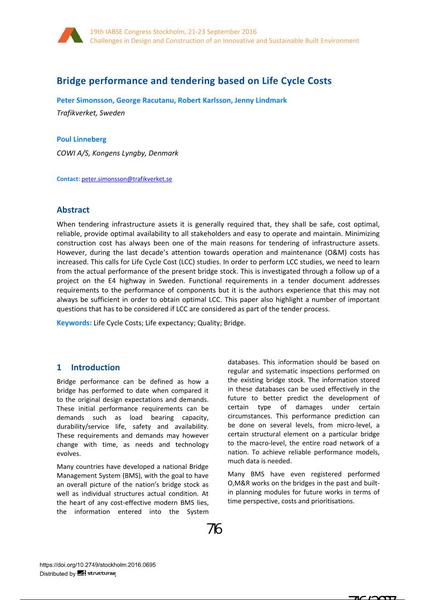Bridge performance and tendering based on Life Cycle Costs

|
|
|||||||||||
Détails bibliographiques
| Auteur(s): |
Peter Simonsson
(Trafikverket, Sweden)
George Racutanu (Trafikverket, Sweden) Robert Karlsson (Trafikverket, Sweden) Jenny Lindmark (Trafikverket, Sweden) Poul Linneberg (COWI A/S, Kongens Lyngby, Denmark) |
||||
|---|---|---|---|---|---|
| Médium: | papier de conférence | ||||
| Langue(s): | anglais | ||||
| Conférence: | IABSE Congress: Challenges in Design and Construction of an Innovative and Sustainable Built Environment, Stockholm, Sweden, 21-23 September 2016 | ||||
| Publié dans: | IABSE Congress Stockholm, 2016 | ||||
|
|||||
| Page(s): | 716-723 | ||||
| Nombre total de pages (du PDF): | 8 | ||||
| Année: | 2016 | ||||
| DOI: | 10.2749/stockholm.2016.0695 | ||||
| Abstrait: |
When tendering infrastructure assets it is generally required that, they shall be safe, cost optimal, reliable, provide optimal availability to all stakeholders and easy to operate and maintain. Minimizing construction cost has always been one of the main reasons for tendering of infrastructure assets. However, during the last decade’s attention towards operation and maintenance (O&M) costs has increased. This calls for Life Cycle Cost (LCC) studies. In order to perform LCC studies, we need to learn from the actual performance of the present bridge stock. This is investigated through a follow up of a project on the E4 highway in Sweden. Functional requirements in a tender document addresses requirements to the performance of components but it is the authors experience that this may not always be sufficient in order to obtain optimal LCC. This paper also highlight a number of important questions that has to be considered if LCC are considered as part of the tender process. |
||||
| Mots-clé: |
pont
|
||||
